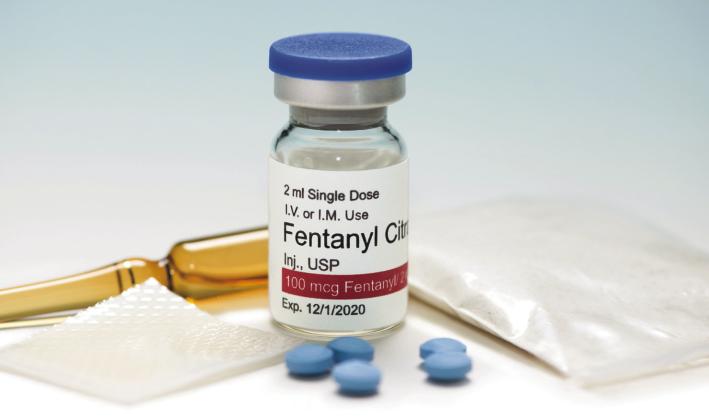FENTANYL. IT SEEMS WE HEAR ABOUT THIS DEADLY DRUG ON A DAILY BASIS, and it’s the rare newscast that doesn’t include at least some mention of its dreadful impact on individuals, families, and the broader society.
What exactly is fentanyl, and why does it warrant so many headlines? According to the Centers for Disease Control and Prevention (CDC), fentanyl is a synthetic opioid that is up to 50 times stronger than heroin and 100 times stronger than morphine. Deadly when ingested in shockingly miniscule amounts (a lethal dose is the approximate size of three grains of sand), this drug and other synthetic opioids claim over 150 lives each day in the United States.
The organization Facing Fentanyl (facingfentanylnow.org), a not-forprofit assembly of grassroots illicit fentanyl awareness groups, states that fentanyl is the leading killer of adults ages 18 to 45. Even more troubling, the organization’s website reports that, “Children under the age of 14 are dying of fentanyl poisoning faster than any other age group.”
Considering the disproportionate havoc fentanyl is wreaking among younger people, it’s vital for parents and other caregivers to educate themselves on the dangers of this drug and how easily their children can come into contact with it unwittingly.
Illicit fentanyl comes in different forms, including powder and liquid. The CDC notes that the powdered form is commonly mixed with other street drugs, such as heroin, cocaine, or methamphetamine, or made to look identical to legitimate prescription drugs. The liquid form is commonly added to products like nasal sprays or eye drops or dropped onto paper or small candies.
With regard to fentanyl-containing counterfeit prescription pills, Facing Fentanyl’s website states that, “These fake pills are made to look identical to legitimate prescription pills—such as Oxycontin, Percocet, Vicodin, Adderall, Xanax and other medicines— and have been found in every state in the country.” Because fentanyl is being deceptively incorporated into almost every other kind of drug—and cannot be seen, smelled, or tasted—many people, including children, are exposed to deadly levels of this opioid without even realizing they’re ingesting it. For this reason, fentanyl awareness organizations and educators believe it’s more accurate to use the term “fentanyl poisoning” rather than “fentanyl overdose” when discussing the adverse health effects and numerous deaths associated with this drug.
Parents should also be aware that, according to Facing Fentanyl, criminal organizations are taking advantage of social media and e-commerce sites to foist fentanyl-laced drugs on unwary children—yet another reason to keep a close eye on kids’ online activities.
When it comes to fentanyl poisoning, quick intervention can save a life, so it’s critical to know what signs to look for and how to respond to this life-threatening emergency. The CDC lists the following symptoms that could indicate fentanyl poisoning: small, constricted “pinpoint” pupils; falling asleep or losing consciousness; slow, weak, or no breathing; choking or gurgling sounds; limp body; cold and/or clammy skin; and discolored skin (especially on lips and nails).
If fentanyl poisoning is suspected, the CDC advises taking five action steps: 1. Call 911 immediately. 2. Administer naloxone if available. (Available in nasal spray and injectable forms, naloxone is a medication that can quickly reverse the effects of opioids and save an individual’s life if administered promptly. Naloxone is available in pharmacies everywhere in the US and can be purchased without a prescription in most states.) 3. Try to keep the person awake and breathing. 4. Lay the person on their side to prevent choking. 5. Stay with the person until emergency assistance arrives. Again, quick action is key in any case of fentanyl poisoning. Responding immediately and appropriately to this scenario can mean the difference between life and death. And, parents, don’t make the faulty assumption that it can’t happen to your child. Remember, a dose of fentanyl equal to just three grains of sand is fatal—and a single fentanyl-laced pill can kill. ✲


